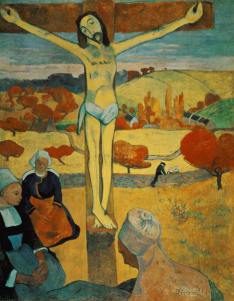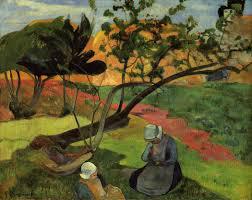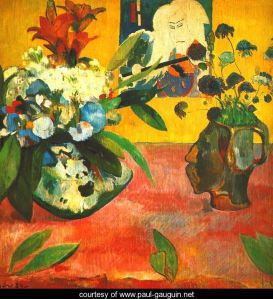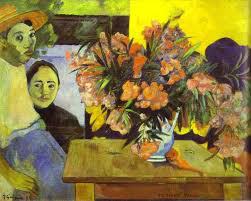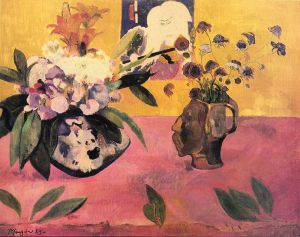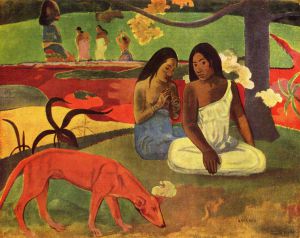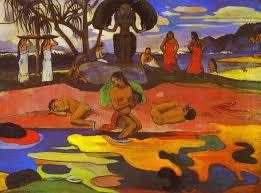Paul Gauguin and Glimpses of Japan: Rich Artistic Soul
Lee Jay Walker
Modern Tokyo Times
The art of Paul Gauguin is extremely rich in quality and when viewing his art you can feel the intensity and uniqueness of such a talented individual. Whatever negatives have been stated about this sublime artist with regards to his private life, this smokescreen must be finished because Gauguin is among the elite of all artists who ever graced this world. If Gauguin is judged for imperfections then what is perfect about an individual striving to make money for his family while facing endless cycles of poverty?
Gauguin in his lifetime faced extreme hardship despite creating stunning art and to add salt into a wound which couldn’t be recovered in his lifetime, after his death many individuals got rich by utilizing capitalism from the work he produced. However, for Gauguin hope often turned to despair and during his final years he tried to find a new way whereby he could be freed by all the conventions which had chewed him up and spat him out.
Redemption and the “Garden of Eden” have been sought by many individuals therefore Gauguin desired to break free from the chains which had caused so much pain and isolation. Yet the years of pent up anguish, struggling against poverty, and other negative factors, isn’t a great start to find something which doesn’t really exist.
The life of Gauguin is extremely intriguing and the same applies to the influence of Japanese art on this soul who “breathed” and “lived” for art. Alex Faulkner who is highly acclaimed in the field of ukiyo-e commented on the Toshidama Gallery website that “He’s a little overlooked compared to contemporaries such as Van Gogh so the current show comes as a welcome revival. The huge influence of Japanese prints in the work of both artists should not be underestimated. Van Gogh made direct copies of Hiroshige prints, writing to his brother that, “this day I have found something wonderful that I shall surely copy,” but it is perhaps less well known that Gauguin also made copies of Japanese prints…”
Alex Faulkner (http://toshidama.wordpress.com) also comments about Gauguin’s time in Tahiti by stating that “Surely though, his later paintings from Tahiti display all the characteristics of the floating world… the lazy, sexual undercurrent, the panoramas of available women, the absence of the modern day and the explicit suggestion of pleasure, all laid out frieze-like on the canvas against a background of flat colour or worked pattern.”
Ukiyo-e is extremely expressive and no subject is sacred therefore the boundaries of this art form is truly rich. Of course, individual ukiyo-e artists focused on different events and areas. Also, many Meiji ukiyo-e artists appear to focus more on a greater richness without the sexuality of the “floating world.” This doesn’t imply anything but the images by Gauguin belong to an older Japanese art tradition within ukiyo-e.
On this (http://www.paul-gauguin.net) website it is commented that “Like his friend Vincent Van Gogh, with whom in 1888 he spent nine weeks painting in Arles, Paul Gauguin experienced bouts of depression and at one time attempted suicide. Disappointed with Impressionism, he felt that traditional European painting had become too imitative and lacked symbolic depth. By contrast, the art of Africa and Asia seemed to him full of mystic symbolism and vigour. There was a vogue in Europe at the time for the art of other cultures, especially that of Japan (Japonisme). He was invited to participate in the 1889 exhibition organized by Les XX.”
“Under the influence of folk art and Japanese prints, Gauguin evolved towards Cloisonnism, a style given its name by the critic Édouard Dujardin in response to Emile Bernard’s cloisonne enamelling technique. Gauguin was very appreciative of Bernard’s art and of his daring with the employment of a style which suited Gauguin in his quest to express the essence of the objects in his art. In The Yellow Christ (1889), often cited as a quintessential Cloisonnist work, the image was reduced to areas of pure colour separated by heavy black outlines. In such works Gauguin paid little attention to classical perspective and boldly eliminated subtle gradations of colour, thereby dispensing with the two most characteristic principles of post-Renaissance painting. His painting later evolved towards Synthetism in which neither form nor colour predominates but each has an equal role.”
Gauguin once commented that “I glimpse poetry” and have “a spark of high intensity.” This “intensity” could turn the most mundane thing into a truly magical work of art and this can be seen by his evolution throughout his career. Also, Gauguin was blessed with high intellect and the richness of his art shows the diversity of a life which refused to be beaten by poverty or convention.
In an earlier article I wrote I comment that “Prior to taking up art Gauguin showed no real tendencies of individuality and providing for his family would be a constant worry for him. However, Gauguin was blessed with sublime gifts but he could not “create like our divine Master” because the ravages of life and reality shackled him and pointed a dagger at his heart.”
“He knew that family obligations were important but with each new winter it was clear that he had to make a stark choice. This must have put a terrible burden on Gauguin because he knew his gifts were indeed great but he was trapped like a bird in a cage.”
“Finally he broke free from a life of normality and Gauguin desired to generate wealth in order to support his family and to bless the world with exquisite art. Gauguin stated “without art there is no salvation” and clearly his inner soul saw a political picture which remained aloof from the majority of people.”
However, if we jump to Tahiti and remember that his only companion in many bleak years was poverty. Then fuse this with the anguish of his son Clovis dying from a blood infection and his favorite daughter Aline dying of pneumonia, it is apparent that the scars of a brutal life ran deep and the nearer he got to the “promised land” the further the rejection. Alas, all this played on the mind of Gauguin and not surprisingly he turned to distant lands in the field of artistic influence like Japan and also left France for a “promised land” which had failed him in Europe.
Gauguin once stated that “without art there is no salvation” but now with or without art there wasn’t any salvation. Aline had been “a ray of sunshine” which kept a brightness in his heart but her death hit home at the bleakness of the reality of Gauguin and his life. After all, this rare individual was blessed with high intellect and stunning art but Gauguin couldn’t escape the ravages of poverty.
Many art critics, like international political leaders and directors at charities who reside in complete comfort, have the snobbery to condemn Gauguin or the poor for creating their own problems. However, no individual can put themselves in the place of another and unless people understand the times of the day and link this with the death of his children and severe poverty – while the onset of time was eating away at his soul – then who can really judge?
In a past article about Gauguin I comment that “Tahiti wasn’t an illusion because all illusions had died in Europe and whatever Gauguin became, he only became this after every deck of cards had gone against him. After all, Gauguin didn’t abandon his children but instead he tried to do the right thing by his family.”
I also comment “The Christian imagery in some of his work alludes to a mythical world where justice and the Garden of Eden can be reached. Tahiti, with its past spirit of purity, was being swallowed up and the same purity of Gauguin was equally being swallowed up.” Indeed, Gauguin himself stated “I am inclined to a primitive state.”
Gauguin searched and experimented throughout a very difficult life and Japanese art was one of many influences that impacted greatly on his artwork. He clearly cherished aspects of ukiyo-e and maybe “the primitive state” he refers to applies to the “primitive nature of this world.” Also, aspects of ukiyo-e focus on the mystery of the underworld and sexuality wasn’t condemned like in the Christian world and Islamic world. Therefore, the influence of ukiyo-e on Gauguin makes natural sense because he was a searcher and conventions couldn’t shackle his creativity.
http://www.guardian.co.uk/artanddesign/2010/sep/27/paul-gauguin-tate-modern-exhibition PLEASE WATCH THIS LOVELY VIDEO
http://toshidama.wordpress.com Toshidama Gallery
http://toshidama-japanese-prints.com/ –
http://toshidama.wordpress.com/2010/10/27/gauguin-in-print/
Modern Tokyo News is part of the Modern Tokyo Times group
DONATIONS to SUPPORT MODERN TOKYO TIMES – please pay PayPal and DONATE to sawakoart@gmail.com
http://moderntokyotimes.com Modern Tokyo Times – International News and Japan News
http://sawandjay.com Modern Tokyo Times – Fashion
https://moderntokyonews.com Modern Tokyo News – Tokyo News and International News
http://global-security-news.com Global Security News – Geopolitics and Terrorism
PLEASE JOIN ON TWITTER
https://twitter.com/MTT_News Modern Tokyo Times
PLEASE JOIN ON FACEBOOK
https://www.facebook.com/moderntokyotimes
Some art and cultural articles by Modern Tokyo Times are republished in order to inform our growing international readership about the unique reality of Japan.
